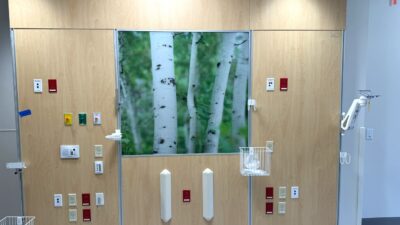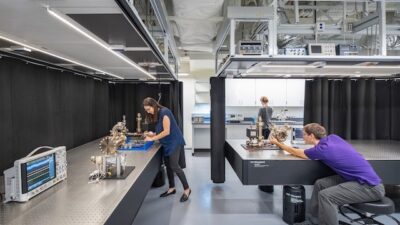Going digital with TAB data saves more than paper--it also saves time, money, and headaches.
In today’s increasingly budget-conscious environment, construction timelines are becoming ever shorter. With less time to build and attain occupancy; delivering high-quality, green, functional buildings has never been more important.
Successfully bringing a building from paper to bricks and mortar requires significant communication among everyone involved in every facet of a project. Typically forests of paper are consumed in the effort to communicate a design and turn a project into reality. The problem is, paper is easily misplaced, often hard to read, and time-consuming to translate into a meaningful format—ultimately, it is not the best means for conveying some of the most important items necessary to construct a quality building.
Many of the stages are heavily digital–subcontractors submit digital documents; testing, adjusting, and balancing (TAB) contractors e-mail test results; and building commissioning agents facilitate computerized digital test plans. Thus, important information that confirms a building in process is meeting the original design intent now is more readily available and easier to share.
Beaudin Ganze Consulting Engineers (BGCE) , Denver, implemented a digital documentation system in fall 2007 at the start of a $200 million construction project at the St. Mary’s Hospital in Grand Junction, Colo. “We were looking for an online collaboration tool for the entire commissioning team,” said Steve Alschuler PE, BCGE project manager. “With the job site being in Grand Junction, the design team in Minneapolis, the mechanical contractor in Denver, and the electrical contractor in Chicago, this project is truly a national effort.”
Often the TAB professional ends up handling quality control on a construction project. Digitally documenting deficiencies and punch-list items helps keep the commissioning team and other subcontractors well informed about issues that might be delaying project completion. Sharing this information digitally helps issues get resolved more quickly and keeps a project on schedule.
Documenting the work and testing process
The TAB process on a job can span across days, or months, depending on the project size. The ability to share the test results and work in progress is simplified with a digital documentation system.
Gary Cummings, president of Tampa, Fla.-based Pro-Tech Diversified said, “We have a fast-track, 15-story patient tower hospital addition. We can have multiple technicians on-site recording data simultaneously and still have one report immediately available since going digital. By capturing data digitally, we can keep both the building owner and the design engineer aware of the job progress at all times. There is no more need for turning in hand written paper field copies.”
The TAB contractor working digitally allows all parties involved to know how the job is progressing in near real-time. Anyone granted access to the TAB project can, with a few clicks of the mouse, go online to see what equipment has passed TAB testing . The “punch list” (items that need fixing) and the subcontractor responsible for making adjustments are all right there.
TAB review process
With the balancing data available digitally online, Pro-Tech implemented a continuous review process. According to Cummings, “Typically, the balancing technician performs all the work and turns in a report to be reviewed by a NEBB [National Environmental Balancing Bureau]-certified professional. Now that we are digital, we are able to review the projects daily and the technicians fix any problems before they leave the job site. In the past, we would have to send someone back out onsite after the review process.”
Many TAB companies perform testing around the world; for transcontinental work, transmitting information digitally saves time, and money spent on return trips.
“Recently we finished a job in Okinawa, Japan,” said Rich Rodgers of Neudorfer Engineers , Seattle. “Before the technician left Japan, we were able to review their reports and help them identify corrections and any re-testing that was needed.”
Building turnover
Attaining a certificate of occupancy is a vital milestone during the final construction process and turnover to the building owner. Without a certificate, the building cannot be occupied. The final TAB report frequently is required to get the certificate. To that end, the ability to quickly turn around an accurate TAB report is crucial. Most TAB contractors using digital documentation can produce the final balance report within hours of the last on-site reading, and deliver all of their final TAB reports 24 to 48 hours of the last reading.
Rodgers of Neudorfer Engineers said, “On a recent job requiring over three months of on-site field testing, we were able to generate a 900-page report within a few hours of the last reading onsite, and deliver the final report to the engineer that same day, because we gather the data digitally.”
The final documentation of a building construction process is also important, and it typically generates reams of paper. If presented with paper-based operation and maintenance manuals and as-built drawings, the building owner usually has to make an additional effort to digitally enter this hard-copy information into their system. If data are shared digitally , it saves the building owner a lot of time in implementing the ongoing asset management system for their facility.
Digital documentation allows for a green, accurate, and fast method to capture and share the TAB test results and findings, and the commissioning results, by cutting paper use. TAB firms that go digital realize increased productivity from their technicians while eliminating redundant data entry and improving standardization. With TAB data digital, a final TAB report is available almost instantly upon project completion, which means a shortened invoice cycle. Add on reductions in fuel, paper, and ink toner and a digitized documentation system proves to be a sound investment with a quick payback.
Stadheim is president of SmartSynQ.com , which delivers mobile digital data capture solutions such as AiRNAB.com and BuildingTest.com . He has 18 years of experience in the commercial construction industry ranging from design, installation, commissioning, and startup of commercial buildings and systems.



